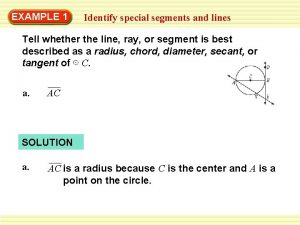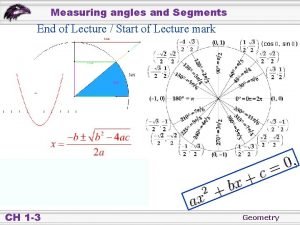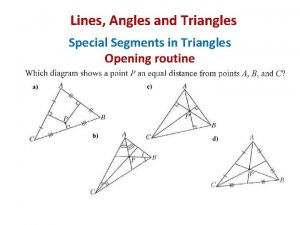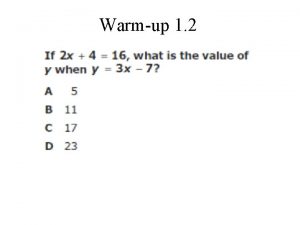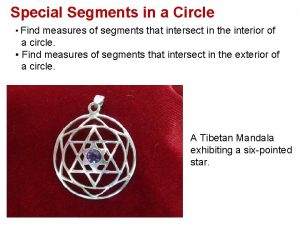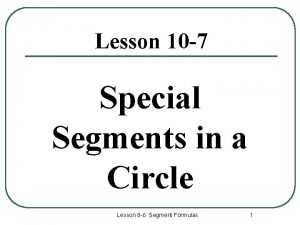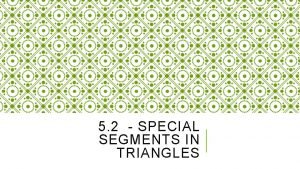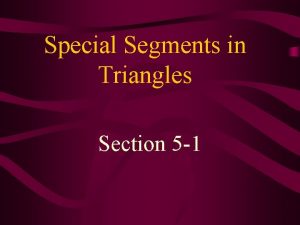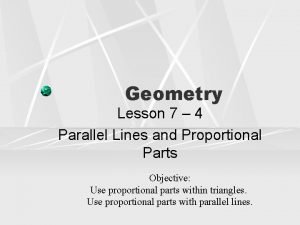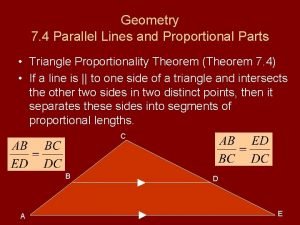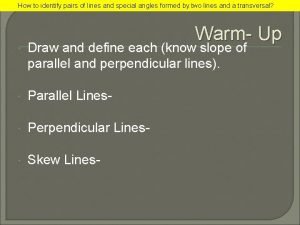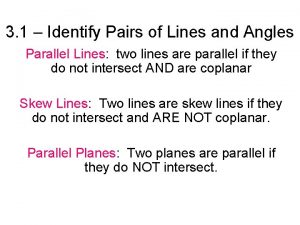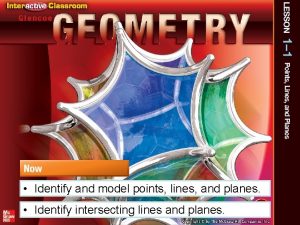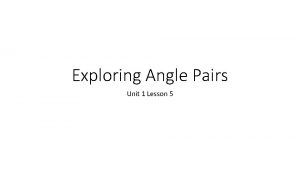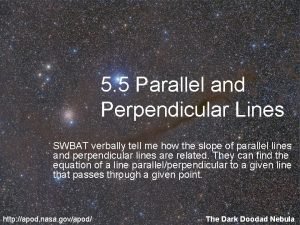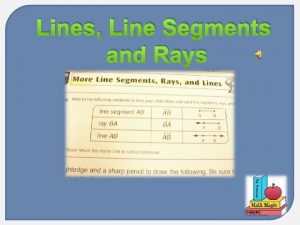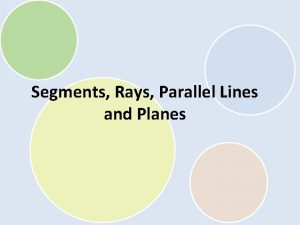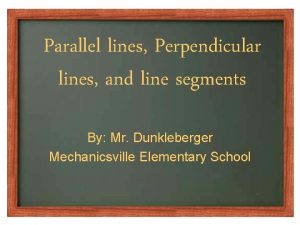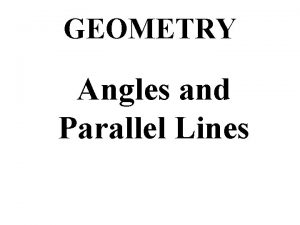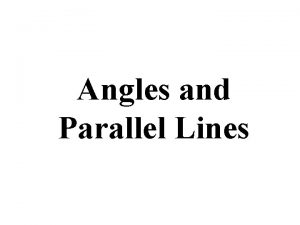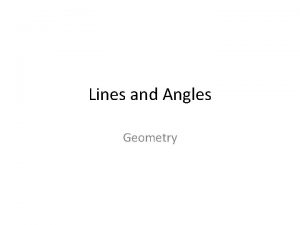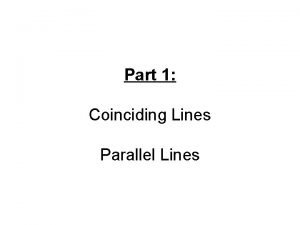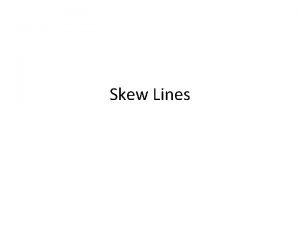EXAMPLE 1 Identify special segments and lines Tell




















- Slides: 20

EXAMPLE 1 Identify special segments and lines Tell whether the line, ray, or segment is best described as a radius, chord, diameter, secant, or tangent of C. a. AC SOLUTION a. AC is a radius because C is the center and A is a point on the circle.

EXAMPLE 1 Identify special segments and lines Tell whether the line, ray, or segment is best described as a radius, chord, diameter, secant, or tangent of C. b. AB SOLUTION b. AB is a diameter because it is a chord that contains the center C.

EXAMPLE 1 Identify special segments and lines Tell whether the line, ray, or segment is best described as a radius, chord, diameter, secant, or tangent of C. c. DE SOLUTION c. DE is a tangent ray because it is contained in a line that intersects the circle at only one point.

EXAMPLE 1 Identify special segments and lines Tell whether the line, ray, or segment is best described as a radius, chord, diameter, secant, or tangent of C. d. AE SOLUTION d. AE is a secant because it is a line that intersects the circle in two points.

GUIDED PRACTICE for Example 1 1. In Example 1, what word best describes AG ? CB ? SOLUTION AG Is a chord because it is a segment whose endpoints are on the circle. CB is a radius because C is the center and B is a point on the circle.

GUIDED PRACTICE 2. for Example 1 In Example 1, name a tangent and a tangent segment. SOLUTION A tangent is DE A tangent segment is DB

EXAMPLE 2 Find lengths in circles in a coordinate plane Use the diagram to find the given lengths. a. Radius of b. c. Diameter of d. Diameter of Radius of A A B B SOLUTION a. The radius of A is 3 units. b. The diameter of c. The radius of d. The diameter of A is 6 units. B is 2 units. B is 4 units.

for Example 2 GUIDED PRACTICE 3. Use the diagram in Example 2 to find the radius and diameter of C and D. SOLUTION a. The radius of C is 3 units. b. The diameter of c. The radius of d. The diameter of C is 6 units. D is 2 units. D is 4 units.

EXAMPLE 3 Draw common tangents Tell how many common tangents the circles have and draw them. a. c. b. SOLUTION a. 4 common tangents b. 3 common tangents

EXAMPLE 3 Draw common tangents Tell how many common tangents the circles have and draw them. c. SOLUTION c. 2 common tangents

GUIDED PRACTICE for Example 3 Tell how many common tangents the circles have and draw them. 4. SOLUTION 2 common tangents

GUIDED PRACTICE for Example 3 Tell how many common tangents the circles have and draw them. 5. SOLUTION 1 common tangent

GUIDED PRACTICE for Example 3 Tell how many common tangents the circles have and draw them. 6. SOLUTION No common tangents

EXAMPLE 4 Verify a tangent to a circle In the diagram, PT is a radius of tangent to P ? P. Is ST SOLUTION Use the Converse of the Pythagorean Theorem. Because 122 + 352 = 372, PST is a right triangle and ST PT. So, ST is perpendicular to a radius of P at its endpoint on P. By Theorem 10. 1, ST is tangent to P.

EXAMPLE 5 Find the radius of a circle In the diagram, B is a point of tangency. Find the radius r of C. SOLUTION You know from Theorem 10. 1 that AB BC , so ABC is a right triangle. You can use the Pythagorean Theorem. AC 2 = BC 2 + AB 2 Pythagorean Theorem (r + 50)2 = r 2 + 802 r 2 + 100 r + 2500 = r 2 + 6400 100 r = 3900 r = 39 ft. Substitute. Multiply. Subtract from each side. Divide each side by 100.

EXAMPLE 6 Find the radius of a circle RS is tangent to C at S and RT is tangent to Find the value of x. C at T. SOLUTION RS = RT Tangent segments from the same point are 28 = 3 x + 4 Substitute. 8=x Solve for x.

GUIDED PRACTICE 7. Is DE tangent to for Examples 4, 5 and 6 C? ANSWER Yes – The length of CE is 5 because the radius is 3 and the outside portion is 2. That makes ∆CDE a 3 -4 -5 Right Triangle. So DE and CD are

GUIDED PRACTICE 8. for Examples 4, 5 and 6 ST is tangent to Q. Find the value of r. SOLUTION You know from Theorem 10. 1 that ST QS , so QST is a right triangle. You can use the Pythagorean Theorem.

GUIDED PRACTICE for Examples 4, 5 and 6 QT 2 = QS 2 + ST 2 Pythagorean Theorem (r + 18)2 = r 2 + 242 r 2 + 36 r + 324 = r 2 + 576 36 r = 252 r=7 Substitute. Multiply. Subtract from each side. Divide each side by 36.

GUIDED PRACTICE 9. for Examples 4, 5 and 6 Find the value(s) of x. SOLUTION Tangent segments from the same point are 9 = x 2 Substitute. +3 = x Solve for x.
 Special segments
Special segments Measuring angles and segments
Measuring angles and segments Special segments in triangles
Special segments in triangles Segment attractiveness matrix
Segment attractiveness matrix 10-5 additional practice secant lines and segments
10-5 additional practice secant lines and segments Lesson 1-3 segments rays parallel lines and planes
Lesson 1-3 segments rays parallel lines and planes Tell me what you eat and i shall tell you what you are
Tell me what you eat and i shall tell you what you are Chord chord theorem
Chord chord theorem Special segments in circles
Special segments in circles Special segments test review
Special segments test review Special segments in triangles
Special segments in triangles Opposite rays
Opposite rays 7-4 geometry
7-4 geometry 7-4 parallel lines & proportional parts
7-4 parallel lines & proportional parts How to show not tell
How to show not tell Plans used for work that has to do with construction
Plans used for work that has to do with construction Transversal line
Transversal line Identify pairs of lines and angles worksheet
Identify pairs of lines and angles worksheet Points lines and planes homework
Points lines and planes homework 1-4 exploring angle pairs
1-4 exploring angle pairs How to tell if lines are parallel
How to tell if lines are parallel
